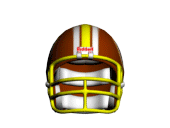Washington Redskins Team History
 Three
Super Bowl championships and 14 playoff appearances since 1971
make the Washington Redskins one of the NFL's most dominant
teams of the past quarter century. But the organization's glorious
past dates back almost 60 years and includes five overall world
championships and some of the most innovative people and ideas
the game has ever known. From George Preston Marshall to Jack
Kent Cooke, from Vince Lombardi to Joe Gibbs, from Sammy Baugh
to John Riggins, plus the NFL's first fight song, marching band
and radio network, the Redskins can be proud of an impressive
professional football legacy. Three
Super Bowl championships and 14 playoff appearances since 1971
make the Washington Redskins one of the NFL's most dominant
teams of the past quarter century. But the organization's glorious
past dates back almost 60 years and includes five overall world
championships and some of the most innovative people and ideas
the game has ever known. From George Preston Marshall to Jack
Kent Cooke, from Vince Lombardi to Joe Gibbs, from Sammy Baugh
to John Riggins, plus the NFL's first fight song, marching band
and radio network, the Redskins can be proud of an impressive
professional football legacy.
George Preston Marshall was awarded the inactive Boston franchise
in July 1932. He originally named the team "Braves"
because it used Braves Field, home of the National League baseball
team. When the team moved to Fenway Park in July 1933, the name
was changed to Redskins. A bizarre situation occurred in 1936,
when the Redskins won the NFL Eastern division championship
but Marshall, unhappy with the fan support in Boston, moved
the championship game against Green Bay to the Polo Grounds
in New York. Their home field advantage taken away by their
owner, the Redskins lost.
Not surprisingly, the Redskins moved to Washington, D.C., for
the 1937 season. Games were played in Griffith Stadium with
the opener on September 16, 1937, being played under flood lights.
That year, Marshall created an official marching band and fight
song, both firsts in the National Football League. That season
also saw the debut of "Slinging Sammy" Baugh, a quarterback
from Texas Christian who literally changed the offensive posture
of pro football with his forward passing in his 16-season career.
The Redskins won five NFL Eastern division titles and NFL championships
in 1937 and 1942 during Baugh's tenure.
Ray Flaherty was Baugh's first pro coach from 1936-1942 and
his 56-26-3 record (.701 percentage) is the best in team history.
In 1944, the Redskins formed a radio network to broadcast their
games throughout the southern United States. By 1950, all Redskins
games were televised over a network of southern stations, thus
making Washington the first NFL team to have an entire season
of televised games. D.C. Stadium (later changed to Robert F.
Kennedy Memorial Stadium) was opened in 1961 and the 55,683-seat
stadium was the Redskins home through 1996. In 1997 the Redskins
moved into the new FedEx Field. A consecutive sellout streak
began in 1968 and is still alive today. No other NFL team can
claim that long a string of sellouts.
In 1969, the legendary Vince Lombardi guided the Redskins to
their first winning record in 15 years but he died of cancer
before the 1970 season. Class of 2002 inductee George Allen
took over in 1971 and coached Washington to 69 victories, five
playoff appearances and the 1972 NFC championship in his seven
years. Joe Gibbs, who led the Redskins from 1981 to 1992, ranks
as the most successful coach in Redskins' history with a 140-65-0
record that produced eight playoff appearances, five NFC Eastern
division championships and victories in Super Bowls XVII, XXII
and XXVI. He was named NFL Coach of the Year in 1982 and 1983
and elected to the Pro Football Hall of Fame in 1996.
In 2004, Gibbs returned to the sidelines when he was hired
as the team's head coach once again. |